Timeline: How the COVID-19 outbreak has evolved in Singapore so far
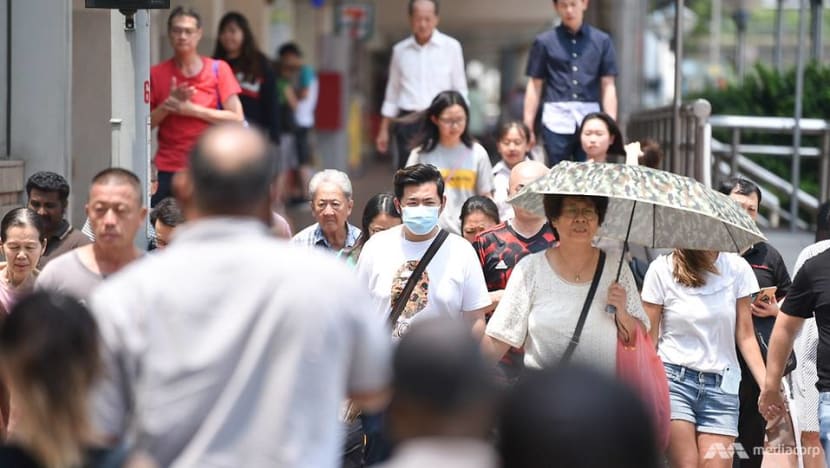
A man seen wearing a protective face mask at Chinatown, Singapore on Mar 11. (Photo: Gaya Chandramohan)
SINGAPORE: It has been more than 12 weeks since Singapore reported its first COVID case on Jan 23 – a 66-year-old Chinese national who came to Singapore three days earlier.
Since then, there have been more than 5,000 cases and 11 deaths in Singapore from the disease, which was first detected in Wuhan, China.
This is how the outbreak has evolved in Singapore so far:
Dec 31, 2019: A cluster of severe pneumonia cases in Wuhan, China is reported to the World Health Organization. Doctors do not yet know its cause.
JANUARY
Jan 2, 2020: Singapore’s Ministry of Health (MOH) says it is aware of the cases in Wuhan and will screen all inbound travellers from Wuhan from the evening of Jan 3.
There are no cases in Singapore.

Jan 4: The first suspect case in Singapore is a three-year-old Chinese national with pneumonia and travel history to Wuhan.
The next day, she tests negative for SARS and MERS-CoV and is diagnosed as having Respiratory Syncytial Virus, a common cause for childhood respiratory infection.
Jan 20: MOH announces it will expand temperature screening to all travellers coming in from China from Jan 22, in light of the Chinese New Year holidays and expected influx of Chinese travellers.
There have been several suspect cases in the days leading up to the announcement, but so far, everyone has tested negative.
Jan 22: Anyone with pneumonia and travel history to China within 14 days will be isolated, it is announced. Anyone with acute respiratory infection who had been to any hospital in China with 14 days will also be isolated in hospital in Singapore.
A multi-ministry task force, chaired by Health Minister Gan Kim Yong and National Development Minister Lawrence Wong, is formed.
Jan 23: FIRST CONFIRMED CASE IN SINGAPORE
A 66-year-old Chinese national from Wuhan arrived in Singapore on Jan 20. He is warded at the Singapore General Hospital and tests positive for the yet unnamed novel coronavirus. Contact tracing begins.
Temperature screening is implemented at all sea and land checkpoints, it is announced.
Wuhan is locked down by Chinese authorities as the number of cases spikes to the hundreds.

Jan 27: Children and pre-school employees in Singapore have to go on a 14-day leave of absence if they had travelled to mainland China.
Singaporeans are advised against making non-essential trips to the Hubei province, which was locked down by the Chinese government.
The POFMA Office issues the first correction direction regarding the coronavirus.
Jan 28: There are now seven cases of the coronavirus in Singapore, all Chinese nationals from Hubei.
New measures are put in by the task force. From noon on Jan 29, all visitors with recent travel history to Hubei or with passports issued in Hubei will not be allowed to enter or transit in Singapore.
Jan 30: Reports have emerged of shops hiking up the price of surgical masks. There are long queues at pharmacies and retail stores, and the Price Controller is called in to look at the issue.
“Profiteering is highly irresponsible and damaging in these uncertain times,” the Ministry of Trade and Industry said.
There are now 13 cases in Singapore, all imported.
READ: Coronavirus in Singapore: The first 7 days
Jan 31: More correction directions are issued for posts on social media about the novel coronavirus. The first scams also emerge of people leveraging on the situation to cheat others.
92 Singaporeans are evacuated from Wuhan.
New visitors of any nationality with recent travel history to mainland China will not be allowed to enter or transit in Singapore from 11.59pm on Feb 1, the task force announces.
FEBRUARY
Feb 1: Four masks per household are handed out by the Government, with advice to wear the masks only when unwell and visiting a doctor.
There are 18 cases in Singapore and no evidence yet of community spread, says the health ministry.
Feb 4: FIRST CLUSTER AT YONG THAI HANG MEDICAL HALL
After two days without any new cases, Singapore reports six more novel coronavirus cases, with four involving human-to-human transmission.
The first cluster emerges – a Chinese medical hall that primarily serves tourists from China. Four cases are linked to the hall, including family members of employees.
There are now 24 cases in Singapore. More precautionary measures are put in place.
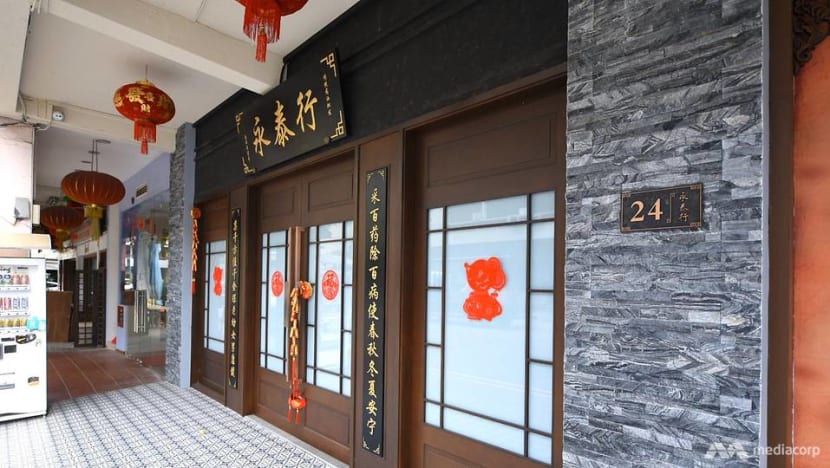
FEB 7: DORSCON ORANGE
The Disease Outbreak Response System Condition (DORSCON) level is raised from Yellow to Orange, with a few local cases emerging without links to previous cases or travel history to China.
Organisers are advised to cancel or defer non-essential large-scale events and people who are unwell, on leave of absence, or with recent travel history to China should not attend any events.
Workplaces should carry out temperature screening and schools will suspend inter-school and external activities till the end of the March school holidays, the task force says.
There are now 33 cases in Singapore.
There is panic buying in the supermarkets. Trade and Industry Minister Chan Chun Sing has reassured people that there is enough stock and asks people to stop panic buying.

Feb 8: Prime Minister Lee Hsien Loong addresses the nation, explaining that the novel coronavirus is more infectious than SARS, but much less dangerous, adding that the situation is evolving.
“Every day brings new developments, and we have to respond promptly and dynamically.” He says Singapore is thinking ahead and “anticipating the next few steps”.
READ: PM Lee urges Singapore to take courage amid coronavirus outbreak, see through stressful time together
There are seven more cases, bringing the total to 40.
A new cluster at The Life Church and Missions Singapore is announced, as is a cluster linked to a business meeting at Grand Hyatt Hotel.
There are now three active clusters. Two people have made a full recovery and have been discharged from hospital – the first time since the first case on Jan 23.
Feb 9: 174 Singaporeans and their family members are flown home from Wuhan.
Four more people are discharged from hospital. There are now 43 confirmed cases.

Feb 10: The Ministry of Manpower orders all dormitories to step up cleaning and precautionary measures.
All mass activities should be suspended and the use of common dormitory facilities should be staggered.
Feb 11: The coronavirus is named by the World Health Organization as SARS-CoV-2, and the virus causes the disease COVID-19.
Feb 12: TWO NEW CLUSTERS ANNOUNCED
Two new clusters – at the Grace Assembly of God church and Seletar Aerospace Heights construction site – emerge.
There are now 50 cases of COVID-19.
Six more cases are discharged, bringing the total number of recovered patients to 15.

Feb 17: A new stay-home notice is announced. More strict than a leave of absence, a person on a stay-home notice cannot leave their residence for 14 days.
All Singapore residents and pass holders returning from China must complete a 14-day stay-home notice.
There are two new confirmed cases, bringing the total to 77 cases. Twenty-four people have been discharged from hospital.
READ: COVID-19 FAQ: When will a stay-home notice be issued, and what does it mean?
Feb 25: A breakthrough, as the contact tracing team finds a link between the Life Church and Missions and the Grace Assembly of God clusters.
It is also the first time serological testing has been used to uncover a COVID-19 patient, who recovered before he/she was tested for the disease.
More measures for employees returning from affected areas are introduced.
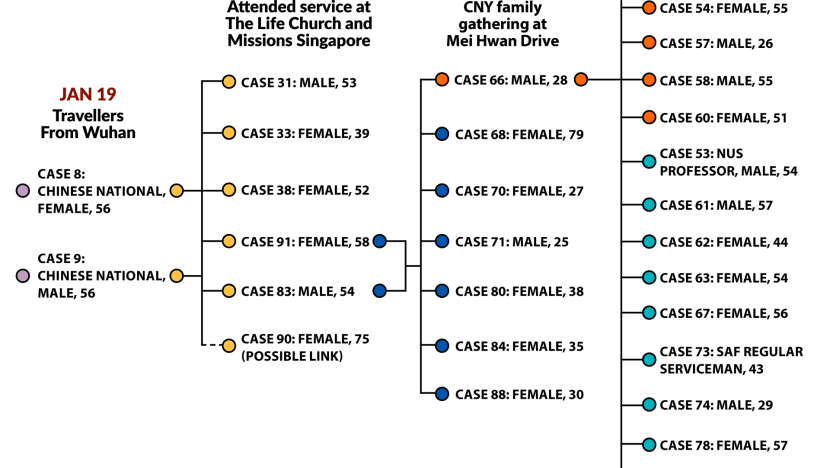
Feb 26: Two Chinese nationals will be charged under the Infectious Diseases Act for giving false information to MOH. A Singapore PR loses his permanent residence status and is barred from re-entering Singapore after breaching his stay-home notice.
Feb 27: A 12-year-old Raffles Institution student tests positive for COVID-19. RI is and MOE Learning Centre in Bishan close for disinfection.
There are now 96 cases in Singapore.
Feb 29: There are more than 100 COVID-19 cases in Singapore, including the announcement of another cluster at Wizlearn Technologies at Science Park.
MARCH
Mar 3: There are more than 90,000 cases around the world. Singapore authorities announce that travellers from Iran, Northern Italy and South Korea will not be allowed to transit or enter Singapore, with outbreaks starting in those countries.
The stay-home notice criteria is expanded.
Mar 5: A new cluster is reported, linked to an event at SAFRA Jurong.
Mar 6: There is a spike in cases, with the daily number of cases in Singapore going into double figures.
Thirteen new cases are announced, bringing the total to 130 cases.
Mar 10: Senior centric activities will be suspended for 14 days from Mar 11 as the SAFRA Jurong cluster, which includes several elderly people, starts to grow.
MOH found that many of the cases were transmitted during social activities and gatherings among seniors. The SAFRA Jurong cluster now has 39 cases.
Mar 12: Mr Lee addresses the nation a second time, warning that COVID-19 will be here “for a long time” and that Singapore needs to plan for a possible spike.
Mosques in Singapore are closed temporarily, after 90 Singaporeans attended a mass religious event in Kuala Lumpur that has been linked to dozens of cases in other countries.
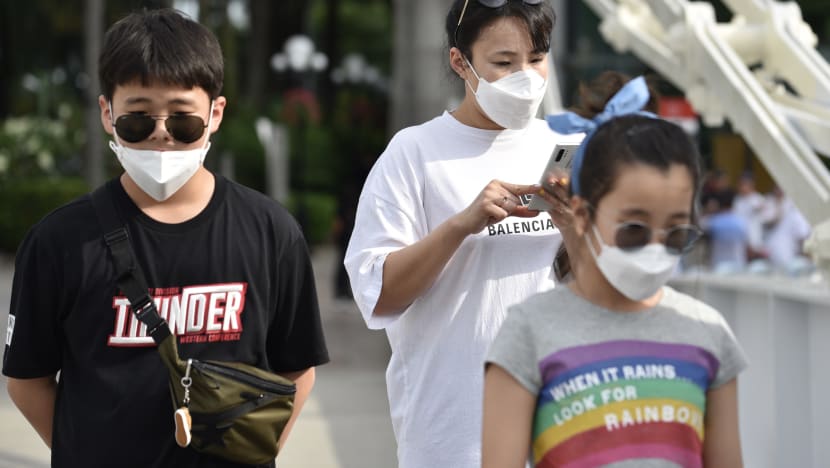
Mar 13: Safe distancing measures are announced. All ticketed cultural, sports and entertainment events with 250 participants or more are to be deferred or cancelled.
Mar 15: The number of local cases accelerates. There are now 226 COVID-19 cases in Singapore, and contact tracing reveals new clusters. The number of imported cases rises slightly, as Singapore residents return from abroad.
Authorities announce that those who enter Singapore with recent travel history to ASEAN countries, Japan, Switzerland or the United Kingdom will be issued a 14-day stay-home notice.
Mar 17: Students overseas are advised to come home to Singapore, as countries around the world go on lock down.
Two days later, flights from the UK are offered to students first, then Singaporeans living overseas who might want to come home.
There are 23 new cases, bringing the total to 266 cases.
Mar 18: A movement control order starts in Malaysia, leading to some people to panic buy in Singapore on concerns that produce from across the Causeway will be cut off. Mr Chan assures people that the supply chain remains intact.
All new and present work pass holders must gain MOM approval before coming back to Singapore. Upon arrival they must undergo a stay-home notice.
MOH announces 47 new cases, a record. Of the new cases, 33 are imported, as more Singaporeans rush home.
Singaporeans are advised to defer all travel abroad.

Mar 20: RISE IN IMPORTED CASES
There are 40 new cases, with 30 imported. Local transmission has come down slightly, but with more Singaporeans rushing home, the number of imported cases remain in the 30s.
COVID-19 is becoming a global challenge with infections across Europe and in the US increasing at a rapid rate.
Stricter safe-distancing measures are rolled out in Singapore, including new measures for F&B outlets.
READ: 40 new COVID-19 cases in Singapore, including 30 imported infections
Mar 21: SINGAPORE ANNOUNCES FIRST 2 DEATHS
A 75-year-old Singaporean woman and a 64-year-old Indonesian have died from COVID-19. Both had underlying health conditions and were in ICU.
89 work passes are cancelled for breach of stay-home notices and entry requirements.
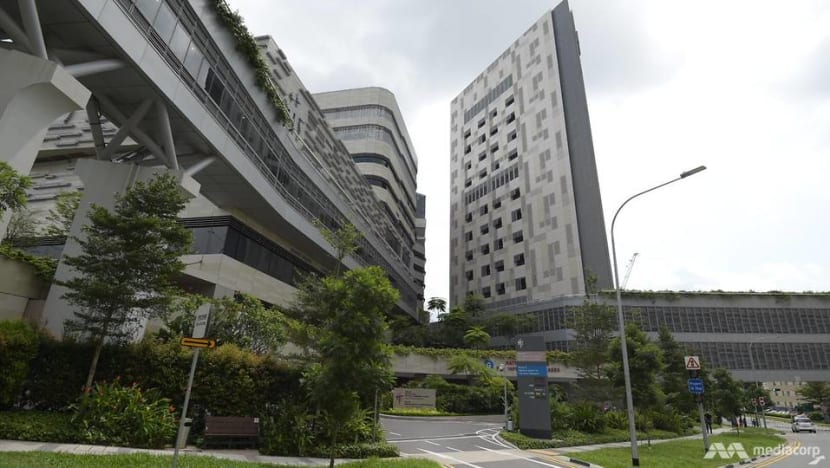
Mar 22: All short-term pass holders are barred from entering or transiting in Singapore.
Mar 24: Safe-distancing measures are ramped up, the task force announces. All entertainment venues have to close, and restrictions will be put in place at malls, museums and attractions.
F&B outlets must ensure sufficient separation of dine-in areas.
All religious gatherings must be cancelled. Tuition centres are to close.
Those coming back from US and the UK have to undergo their stay-home notice in dedicated facilities.
MOH reports 32 new imported and 17 new local COVID-19 cases. Local cases start to climb.
Mar 27: Mr Lee gives a wide-ranging interview to reporters about COVID-19, touching on the Resilience Budget and how Singapore plans to tackle COVID-19.
There are 49 new cases, of which 22 are imported, 18 are linked to previous clusters and nine cases are unlinked.
There are several new clusters by this time, and 732 cases in total.
READ: If we need to do more, we will: PM Lee says economic challenge from COVID-19 very grave, but Government doing all it can
READ: 'The tide is still coming in': PM Lee says COVID-19's impact on healthcare a 'very big problem'
Mar 29: THIRD DEATH
A 70-year-old Singaporean man becomes the third person to die from complications due to the disease in Singapore. He had a history of hypertension and hyperlipidaemia.
Mar 30: Several new clusters are announced, including one at the S11 dormitory in Punggol.
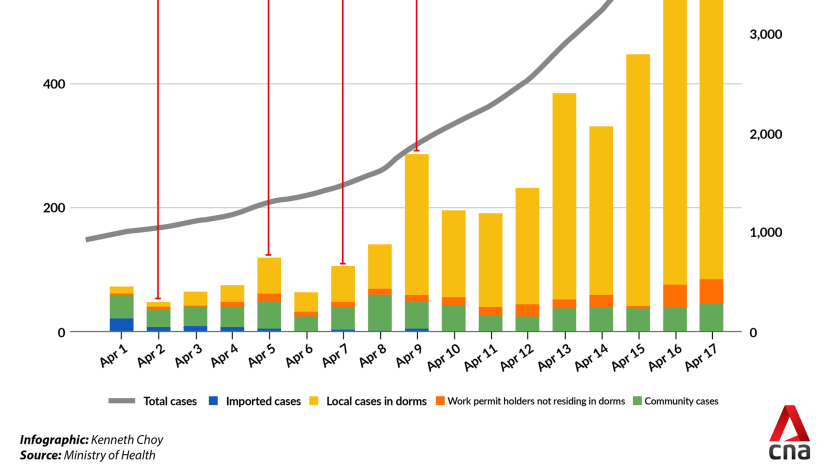
Mar 31: Imported cases start to drop, but local transmission cases rise.
Singapore announces 47 new COVID-19 cases, of which only 16 are imported. Of the rest, 13 are linked, and 18 are unlinked.
Lawrence Wong says: “Our focus now has to be on our locally transmitted cases, especially the cases that are still popping up; particularly worrying are the unlinked cases.”
People are urged to stay at home as much as possible.
There are now 926 COVID-19 cases in Singapore, and another cluster in a dormitory is discovered.
APRIL
Apr 2: Fourth person dies from COVID-19, a 68-year-old Indonesian national who was a Singapore work pass holder. He had a history of diabetes and hypertension and had spent seven days in ICU.
Safe distancing measures are introduced at markets.
Apr 3: Fifth person dies from COVID-19, an 86-year-old Singaporean woman from Lee Ah Mooi nursing home, where a cluster has formed.
There are 65 new cases, of which nine are imported. Forty cases are linked to previous cases, while 16 are unlinked.
Prime Minister Lee Hsien Loong announces a “circuit breaker” will run from Apr 7 to May 4. Only essential services can continue to keep their premises open, and all schools will close and students shift to home-based learning.
Apr 4: Another person dies from COVID-19, an 88-year-old Singapore PR.
There are now clusters in several dormitories, including S11 @ Punggol, Westlite Toh Guan, and Toh Guan Dormitory. The next day, additional measures are announced to contain clusters in dormitories.
There are 75 new cases, of which six are imported. Local transmission numbers continue to rise, as do unlinked cases.
Apr 5: 120 new cases are announced – the biggest spike yet. Only four of these cases are imported as countries around the world lock down air travel. Fifty of the cases are linked to previous cases, but the unlinked cases spike, from 29 the day before to 66.
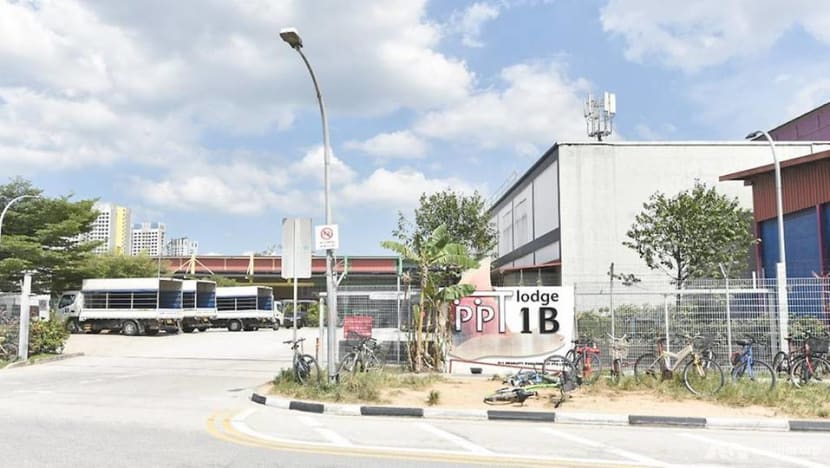
Apr 7: CIRCUIT BREAKER COMMENCES
Of the 106 new cases announced, only three are imported. More clusters are found in dormitories across Singapore.
There are now 1,481 cases in the country.
Apr 8: 142 new cases are reported. Local cases continue to rise as imported cases fall again – this time to just two. A total of 72 cases are pending contact tracing, as unlinked number of cases continue to rise.
Warnings are handed out to people flouting the “circuit breaker” rules.
Apr 9: The biggest spike yet, with 287 cases.
Of these, 217 are linked to known clusters, with those linked to the dormitories continuing to grow. There are only three imported cases.
More warnings and advisories are handed out.
READ: Day 2 of COVID-19 'circuit breaker' sees more than 3,000 breaches of safe distancing measures
Apr 10: A seventh person has died, a 86-year-old woman linked to the Lee Ah Mooi Old Age Home cluster. She died on Apr 9 night, after she was admitted to NCID on Apr 1.

Apr 11: An eighth person dies from COVID-19, a 90-year-old Singaporean man.
Apr 12: Stiffer penalties are introduced for those who continue to flout the rules – there will be no more written arnings and a S$300 fine for the first offence.
A total of 233 new cases are reported, with 167 pending contact tracing – 141 are work permit holders living in dormitories, work sites, or living quarters.
There are no imported cases for the third day in a row.
Apr 13: Singapore reports 386 infections, with the vast majority linked to dormitories. Eight foreign worker dormitories are declared isolation areas under the Infectious Diseases Act.
A 65-year-old male Singapore citizen dies from complications due to COVID-19 infection, MOH announced. He is the ninth person in Singapore to die from the disease.
Apr 14: A 70-year-old Singaporean man, who is linked to the SAFRA Jurong cluster, dies from COVID-19. He is the country's 10th fatality.
Singapore reports another 334 cases.
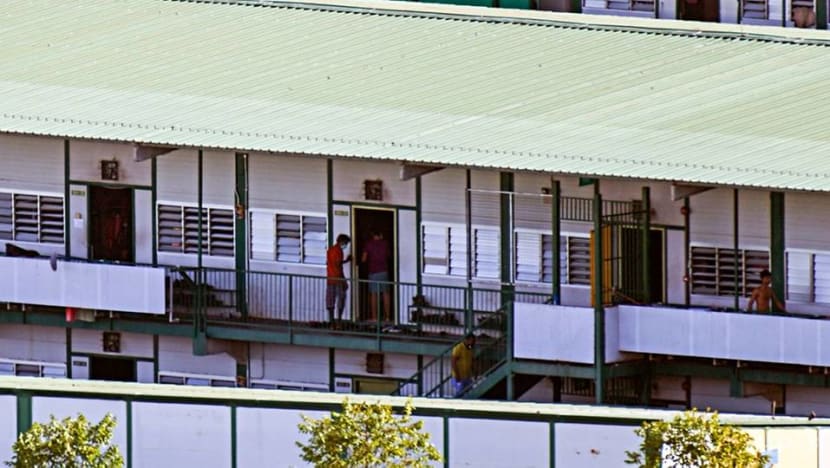
Apr 15: Singapore reports 447 new cases, with 404 linked to foreign worker dormitories.
An 80-year-old Malaysian who tested positive for COVID-19 posthumously died on Apr 13 from causes not related to COVID-19, said the ministry.
Apr 16: The record numbers continue to grow, with 728 new cases reported.
A total of 654 new cases are from foreign worker dormitories, while 26 are work permit holders residing outside dormitories. There are no new imported cases.
Apr 17: Singapore reports 623 new COVID-19 cases, taking the total number of cases past 5,000.
Of the new cases, 558 are linked to foreign workers dormitories, while 37 are work permit holders living outside dormitories.
MOH reported 27 cases in the community. It is day 11 of the circuit breaker, and the average number of cases has dropped - from an average of 40 cases per day in the week before to an average of 32 cases per day in the last week.
There is one new imported case.
A 95-year-old Singaporean man died on Apr 17 from complications due to COVID-19. He had tested positive for the infection four days before. The man is the 11th fatality in Singapore.
Apr 18: A record 942 new COVID-19 cases are reported, with the "vast majority" being work permit holders living in foreign worker dormitories.
The number of local cases continues to decline – 14 of the new cases are Singaporeans or permanent residents.
BOOKMARK THIS: Our comprehensive coverage of the coronavirus outbreak and its developments
Download our app or subscribe to our Telegram channel for the latest updates on the coronavirus outbreak: https://cna.asia/telegram














